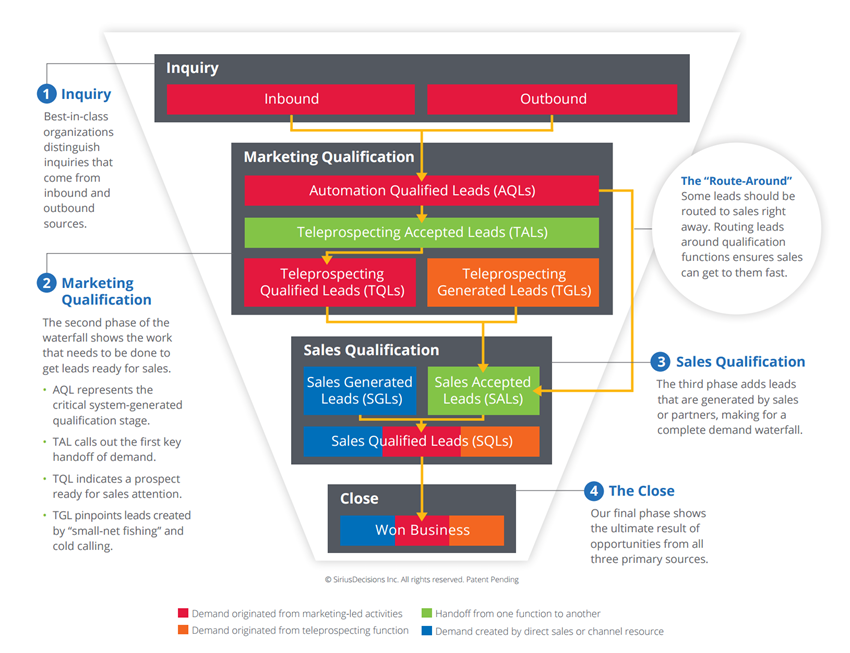The Unbreakable Value Chain: Marketing and Sales
Pick up any literature focused on marketing functions in the business world. A common theme is always the struggle between marketing teams and their age-old rivals, the sales squad. However, forward-thinking organizations throughout the last few decades, regardless of size, owe their fundamental success to a well-oiled marketing-sales machine, essentially blurring the lines between the two traditionally separate departments.
 The key realization is the following: sales and marketing alignment means that a linear success path becomes circular, and a campaign never truly ends, it just evolves.
The key realization is the following: sales and marketing alignment means that a linear success path becomes circular, and a campaign never truly ends, it just evolves.
Marketing does not simply produce leads for sales, handing them over and focusing on the next batch. Instead, marketing enables sales success with the created leads by continuously nurturing these leads with additional content and tactics. Additionally, sales feeds the marketing force with insights about prospects needs, pain points, and trends which are then transferred back into the overall message and content production.
Knowledge transfer is vital to the value chain. It is continuous and flows bidirectionally in all mature, winning organizations.
What keeps the individual links in the marketing & sales value chain strong?
Speaking one language – content is key and the message must be consistent.
It’s remarkable to come across corporations in which entire marketing teams occupy their time organizing events, picking out stock photos for brochures and retweeting content from a set list of accounts curated by a long-lost marketing leader many moons ago… all the while having never seen a sales demonstration, never having tested the product or never having performed an elevator pitch on the top 3 differentiating USPs. Do these crucial players in an organization understand the potential market share they are trying to harness with their disparate one-off marketing tactics? Are they up to speed with the last few clients acquired by their top five competitors, and potential reasons as to why? Often, no. Is the marketing team entirely to blame? Also, no.
As the adage goes, knowledge is power. By enabling communication directly between sales, inside sales and marketing on a regular basis, and by setting forth the driving themes of each year broken down into campaigns, each person in the tightly knit value chain will deliver consistent, logical and relevant points to the outside world. After all, how can your prospects understand what value you bring to the table if your own team players can’t? Start internally, then deliver the highlights systematically to your prospects.
People, processes, and systems – roles, responsibilities, definitions, and methods are internalized by all.
Is your inside sales representative spending the day making calls based on a local Excel sheet? Does your sales executive enter all meeting notes into a Salesforce Opportunity mask which marketing has never even stumbled across? When an inbound lead via an old-school telephone call to the front desk receptionist tumbles in, who is first in line to type that juicy information into the CRM? Or is the information first sent as an e-mail to the sales rep responsible for the region? Or does inside sales pick up all call-related inquiries first?
So many questions. So much room for misunderstanding when people, processes, and systems are not clearly defined. The value chain can only thrive when each important player knows what to do, when, and where.
Having all eyes on the same prize – ultimate goals and KPIs are set, understood, and communicated from the get-go.
The yearly sales and marketing kick-off needs a clear highlighting of team goals as well as sub-team KPIs, along with the campaigns planned to ensure those figures are reached. SLAs are understood and signed off on by each employee, leaving no room for doubt. Reminders in forms of weekly updates as well as a clear lead generation, conversion and contribution to profit gauge dashboard are extremely valuable to all team players focused on success.
When knowledge is key, which data keeps everyone on the path to profit?
Lead Generation efficiency metrics to consider:
-
Lead Cost per Opportunity
-
Lead to Opportunity conversion rate
-
Lead to Appointment cycle length
Lead Generation Effectiveness metrics to consider:
-
Percentage of Leads that meet the Ideal Customer Profile
-
Lead Generation Pipeline Contribution
-
Opportunity by Lead Source
-
Closed deals by Lead Source
-
Number of returned leads from Sales
 SiriusDecisions Demand Waterfall model: Where the marketing & sales value chain shines
SiriusDecisions Demand Waterfall model: Where the marketing & sales value chain shines
Mitigate risk by ensuring gaps and the, therefore, necessary adhoc actions are instantly visible, allowing quick reactivity across the chain.
Planning to succeed, not just on January first and as part of the annual kick-off, but regularly during all-hands sessions and campaign attack meetings is critical. Keeping everyone involved and part of the same master plan, leaving the little possibility for slackers or uninformed stragglers, is becoming an increasingly easier job as the tools and functions in the sales and marketing value chain become more widely adopted. Invest now to profit sooner, rather than later.
If you would like to hear more on how to best bridge the gap between the sales and marketing teams tune into the most recent CMS-Connected Show recorded with a LIVE audience at 404 Conference as we welcomed a panel of well-known expert guests to the show including Bruce Williams, Keith Durrant, Michael Kinkaid, and Vince Mayfield:

Janine Olariu
Janine is a marketing and sales professional based in Dublin, Ireland, with a history of director roles at SaaS, FinTech and social media companies across Europe. With over 10 years in strategic B2B marketing roles, Janine enjoys sharing her experiences and best practices on demand generation, the customer buying journey and marketing-influenced deal acceleration throughout the sales cycle.